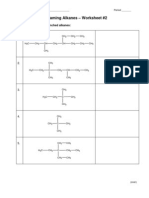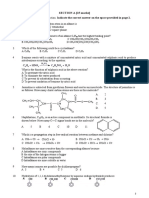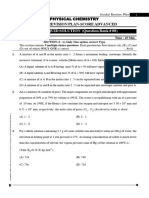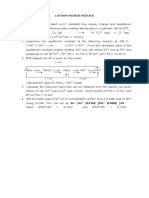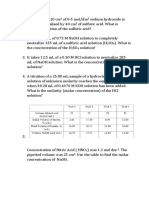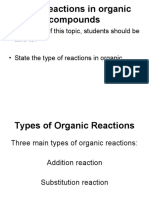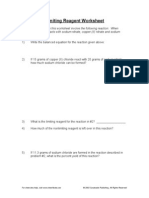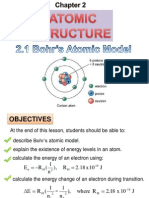Limiting Reactant Worksheet 4
Uploaded by
Kamariah IsmailLimiting Reactant Worksheet 4
Uploaded by
Kamariah IsmailLimiting Reactant Worksheet: 1. Methanol, CH3OH, an excellent fuel, can be made by the reaction of carbon monoxide and hydrogen.
CO(g) + 2 H2(g) CH3OH(l) Suppose 356 grams of CO are mixed with 65.0 of H2. Which is the limiting reactant? What is the maximum mass of methanol that can be formed? What mass of the excess reactant remains after the limiting reactant has been consumed? 2. You have 20.0 grams of elemental sulfur, S8, and 160 grams of O2. Which is the limiting reactant in the combustion of S8 in oxygen to give SO2 gas? What amount of which reactant (in moles) is left after complete reaction? What mass of SO2 in grams is formed in the complete reaction? S8(s) + 8 O2(g) 8 SO2(g) 3. Aluminum chloride, AlCl3, is an expensive reagent used n many industrial processes. It is made by treating scrap aluminum with chlorine according to the following balanced equation: 2 Al(s) + 3 Cl2(g) 2 AlCl2(s)
Which reactant is limiting if 2.70 grams of Al and 4.05 grams of Cl2 are mixed? What mass of AlCl3 can be produced? What mass of the excess reactant remains when the reaction is completed? 4. Disulfur dichloride, S2Cl2, is used to vulcanized rubber. It can be made by treating molten sulfur with gaseous chlorine. S8(g) + 4 Cl2(g) 4 S2Cl2(g)
Starting with a mixture of 32.0 grams of sulfur and 71.0 grams of Cl2, which is the limiting reactant? What mass of S2Cl2 (in grams) can be produced? What mass of the excess reactant remains when the limiting reactant is consumed?
5.
Ammonia gas can be prepared by the reacation of a basic oxide like calcium oxide with ammonium chloride, an acidic salt. CaO(s) + 2 NH4Cl(s) 2 NH3(g) + H2O(g) + CaCl2(s)
If 112 grams of CaO and 224 grams of NH4Cl are mixed, what is the maximum possible yield of NH3? What mass of the excess reactant remains after the maximum amount of ammonia has been formed? 6. Phosphorus trichloride, PCl3, is a commercially important compound used in the manufacture of pesticides, gasoline additives, and a number of other products. It is made by the direct combination of phosphorus and chlorine. P4(l) + 6 Cl2(g) 4 PCl3(l) What mass of PCl3(l) forms in the reaction of 125 g P4 with 325 g Cl2(g)? Show your work.
You might also like
- 33 Austrian Chemistry Olympiad National Competition: Name:.......................................No ratings yet33 Austrian Chemistry Olympiad National Competition: Name:.......................................12 pages
- Answer All Questions in This Section. Indicate The Correct Answer On The Space Provided in Page 2No ratings yetAnswer All Questions in This Section. Indicate The Correct Answer On The Space Provided in Page 25 pages
- H NMR Practice Problems: Youngstown State UniversityNo ratings yetH NMR Practice Problems: Youngstown State University31 pages
- 02 Oc Roadmap Student Copy 1595063648 PDFNo ratings yet02 Oc Roadmap Student Copy 1595063648 PDF1 page
- 2021 JC2 Prelim H1 Chemistry Paper 1 QPNo ratings yet2021 JC2 Prelim H1 Chemistry Paper 1 QP12 pages
- Cambridge International AS & A Level: Chemistry 9701/11No ratings yetCambridge International AS & A Level: Chemistry 9701/1116 pages
- Classification of Organometallic CompoundsNo ratings yetClassification of Organometallic Compounds28 pages
- Questions From Previous Chemistry 116 ExamsNo ratings yetQuestions From Previous Chemistry 116 Exams21 pages
- Chemistry Test Additives: No. Types of Food Food Dye Sweetener Flavor Enhancers PreservativesNo ratings yetChemistry Test Additives: No. Types of Food Food Dye Sweetener Flavor Enhancers Preservatives1 page
- Ap Chemistry Acid-Base Exam Part I Multiple Choice: K (Hco) (Co) (H O) K (Co) (Co) (OH)No ratings yetAp Chemistry Acid-Base Exam Part I Multiple Choice: K (Hco) (Co) (H O) K (Co) (Co) (OH)8 pages
- Limiting-Reagent-Worksheets-1-print_014443No ratings yetLimiting-Reagent-Worksheets-1-print_0144432 pages
- 9-2b Limiting Reactant and Percent Yield WorksheetNo ratings yet9-2b Limiting Reactant and Percent Yield Worksheet2 pages
- 9-2b Limiting Reactant and Percent Yield WorksheetNo ratings yet9-2b Limiting Reactant and Percent Yield Worksheet2 pages
- Limiting Reactant & Percent Yield Combination ProblemsNo ratings yetLimiting Reactant & Percent Yield Combination Problems2 pages
- Department of Chemistry University of Texas at Austin: Forces of Attractions - Supplemental WorksheetNo ratings yetDepartment of Chemistry University of Texas at Austin: Forces of Attractions - Supplemental Worksheet1 page
- Stoichiometry: Complete Table For Any Amount GivenNo ratings yetStoichiometry: Complete Table For Any Amount Given3 pages





